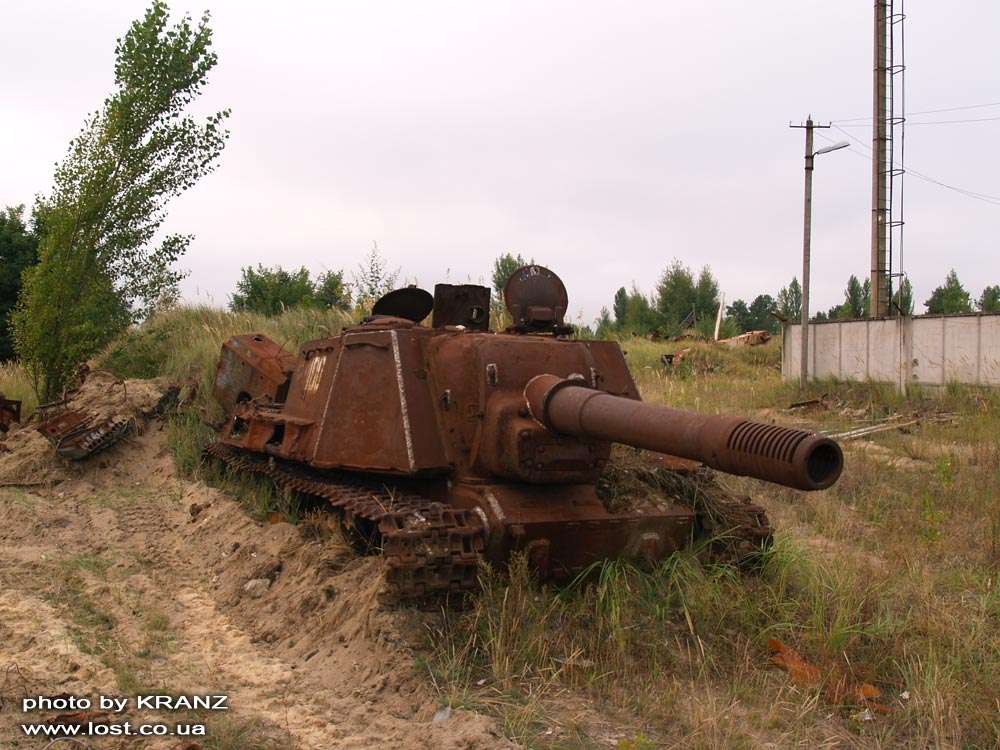
The Radioactive ISU-152 at Chernobyl
Nothing says the Soviet Union more than using a WWII-era ISU-152 assault gun to blow a hole in a concrete wall below a melting nuclear reactor. As crazy as this seems, this is something that nearly happened back in the 1980s.
It was April 1986, and the Chernobyl Nuclear Power Plant had recently experienced a catastrophic meltdown, covering the surrounding landscapes and urban areas with high levels of radiation.
The ensuing clean-up operation soon realised that water from their firefighting efforts had flowed into the reactor’s basement, and was at risk of poisoning the ground water.
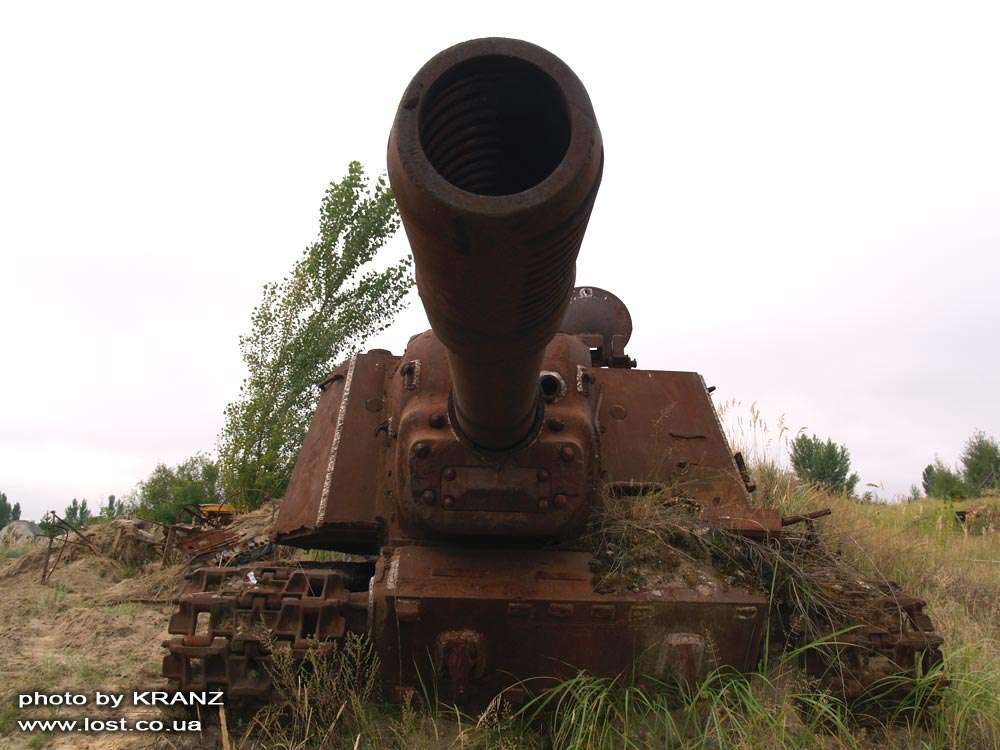 The big 152 mm ML-20S muzzle break on the Chernobyl ISU-152. Image courtesy of Yevgen KRANZ Goncharenko, and lplaces.com.
The big 152 mm ML-20S muzzle break on the Chernobyl ISU-152. Image courtesy of Yevgen KRANZ Goncharenko, and lplaces.com.
Engineers needed to access the basement to solve this issue. One problem – the basement was enclosed by thick concrete walls.
Just how did they propose to get through? By bringing in old WWII-era assault guns to literally blast a hole through the walls. Subtle.
When this was revealed to be a not-very-clever plan, the ISU-152s were repurposed as bulldozers to tear down local buildings – because if a 152 mm howitzer isn’t of any use during a nuclear meltdown, 50 tons of steel probably is.
The Chernobyl disaster
The accident at the nuclear power plant on the 26th April 1986 was the result of the poor design of the RBMK-type reactor, and an ill-conceived safety test of the emergency cooling system. In a failed attempt to simulate the loss of external power, the Number 4 reactor ruptured when the core melted and steam explosions destroyed the nuclear vessel.
The resulting catastrophe irradiated the nearby town of Pripyat, where the staff and families of the power plant resided, and also heavily contaminated large areas of Ukraine and Belarus.
 Reactor 4 after the explosion at the power plant.
Reactor 4 after the explosion at the power plant.Soviet obsession with secrecy and the Communist Party’s inability to accept bad news, along with stifling bureaucracy meant that Pripyat was not evacuated for nearly 24 hours, and formal news of the disaster was not revealed to the world until the 28th April.
The clean-up of the site has been ongoing to this date, but initial efforts were undertaken by the Soviet military, including a significant effort from helicopter pilots.
 A helicopter spraying decontamination liquids over the Chernobyl site. Image by IAEA Imagebank CC BY-SA 3.0.
A helicopter spraying decontamination liquids over the Chernobyl site. Image by IAEA Imagebank CC BY-SA 3.0.
Similarly, the employment of Red Army troops to remove radioactive debris from the roof of the containment building was undertaken in extremely hazardous conditions.
One urgent requirement was to gain access to a basement under the reactor building that was flooded with fire-fighting water – it was feared that it could escape the basement and contaminate the local groundwater.
A way to pierce the concrete exterior of the basement had to be found so a pipe could be introduced to allow liquid nitrogen to freeze this water pool.
This is where the ISU-152 enters the story.
The ISU-152
The ISU-152 is one of the Soviet Union’s legendary Second World War armored vehicles, alongside the T-34 and IS-2. It is a monstrous assault gun, weighing 52 tons and armed with a massive 152mm gun-howitzer.
While this beast was originally intended for use against buildings and fortifications, it also happened to work extremely well against German tanks, such as the Tiger and Panther.
 An ISU-152. This version is taller, and its sides are less angled than the SU-152. Image by Ieee5392 CC BY-SA 4.0.
An ISU-152. This version is taller, and its sides are less angled than the SU-152. Image by Ieee5392 CC BY-SA 4.0.
The vehicle started as the SU-152, based on the KV-1, but when production of the KV-1 stopped the design was updated to be built on the IS chassis in late 1943, and was renamed to ISU-152.
The ISU-152s at Chernobyl
One of the ideas conjured by the Soviets to get into the reactor basement, was to literally punch a hole in it with a large caliber round. But what vehicle in the Soviet inventory could take on this challenge? How about the WWII-era ISU-152 – a machine that was born for the job of concrete-destruction.
Accounts vary, but between three and eleven examples of the ISU-152 were deployed to the Chernobyl site to assist engineers accessing the flooded reactor basement. They were taken from the 22nd Guards & Red Banner Tank Division, which was based around 300 miles (480 km) away
 Two of the ISU-152s used at Chernobyl with their crews.
Two of the ISU-152s used at Chernobyl with their crews.
It was thought the assault guns’ heavy armour would shield the crew from radiation exposure, and that the specialised 53-G-545 concrete-piercing shell fired by the 152 mm ML-20s howitzer of the ISU-152 could open a suitably sized hole for the nitrogen pipe.
However, when this concept was tested on a similar concrete wall away from the accident site, the resultant hole was too small for the pipe, and several shots were found to collapse large sections of the wall, possibly leading to an even bigger problem if this was tried at the reactor basement.
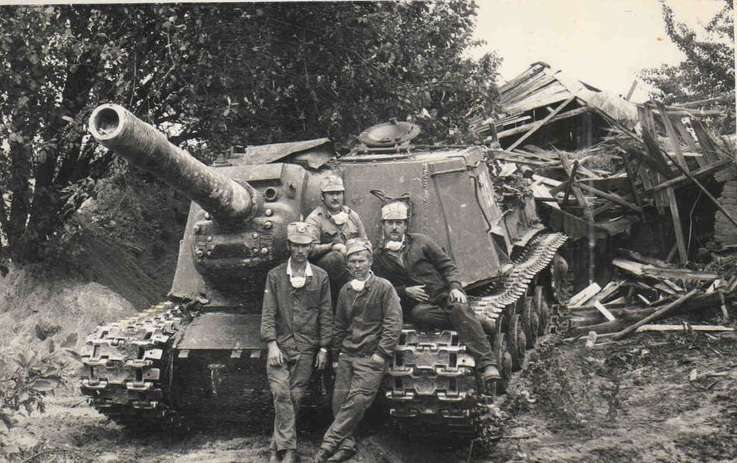 ISU-152 crew beside their vehicle after more bulldozing work.
ISU-152 crew beside their vehicle after more bulldozing work.
After consultation, it was decided by the engineers to abandon this idea, and instead burrow under the basement using miners, and introduce the nitrogen pipe by this method instead.
In actual fact, the idea of introducing liquid nitrogen was totally abandoned, and the space from the mining operation and another cooling proposal was filled with concrete to stabilise the basement.
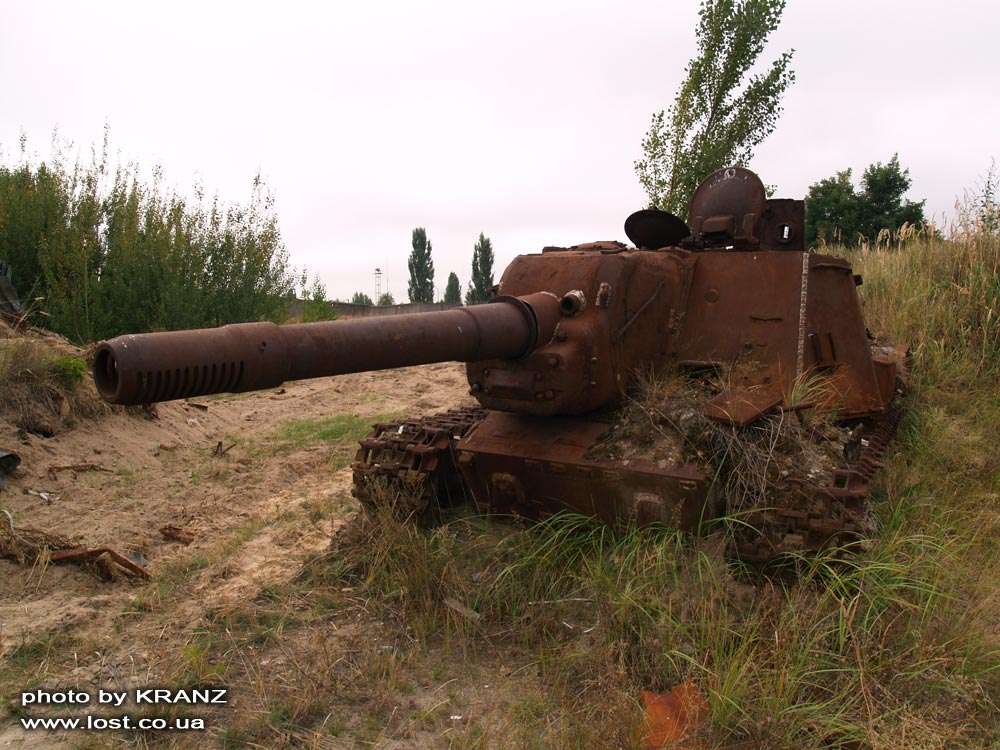 ISU-152 bort number 100 in the exclusion zone. Image courtesy of Yevgen KRANZ Goncharenko, and lplaces.com.
ISU-152 bort number 100 in the exclusion zone. Image courtesy of Yevgen KRANZ Goncharenko, and lplaces.com.
A decision was made to demolish buildings around the reactor site and surrounding villages – this was primarily done because the wooden constructions trapped radiation that could be released by natural fires, with no prospect of fire-fighting services in the exclusion zone.
When the first sarcophagus was erected over the reactor building more buildings were demolished to make way for the components to be brought closer to the damaged reactor.
 One of the converted assault guns, using its weight and traction to bring down a large building near Chernobyl.
One of the converted assault guns, using its weight and traction to bring down a large building near Chernobyl.
As bulldozers and other equipment would have to be trucked in, the decision was taken to utilise the ISU-152s, which were already on site with their crews, to be employed in this demolition role instead.
The ISU-152s were modified to perform this task, with the driver’s viewing prism replaced by special anti-radiation glass, and the vehicle’s armoured skirts removed to make the task of clearing irradiated mud from the tracks easier. At least one of them had their gun removed and the gap covered by lead.
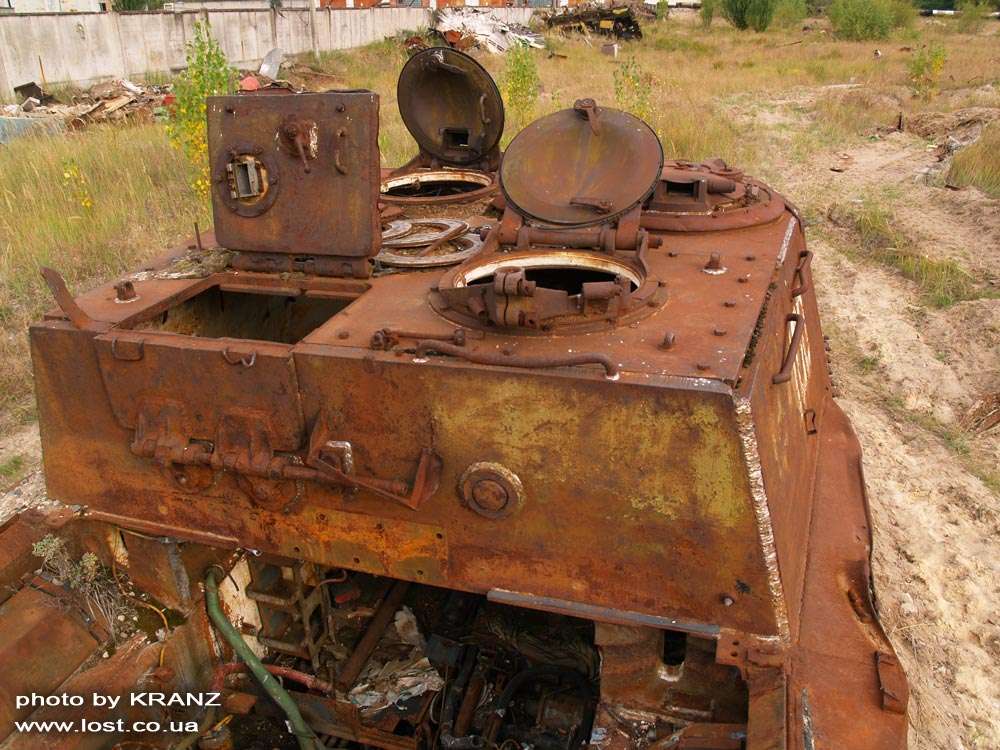 A view from the engine deck of ISU-152 number 100. Many components have been stripped, including the engine. Image courtesy of Yevgen KRANZ Goncharenko, and lplaces.com.
A view from the engine deck of ISU-152 number 100. Many components have been stripped, including the engine. Image courtesy of Yevgen KRANZ Goncharenko, and lplaces.com.
No finesse was required for this particular job, and the heavy ISU-152 was easily able to flatten the small wooded buildings, which were then bulldozed along with uprooted trees and other materials into huge pits.
These pits were covered in soil and sprayed with a plasticised layer to inhibit plant growth and to weather-seal the surface, then marked with simple contamination signs.
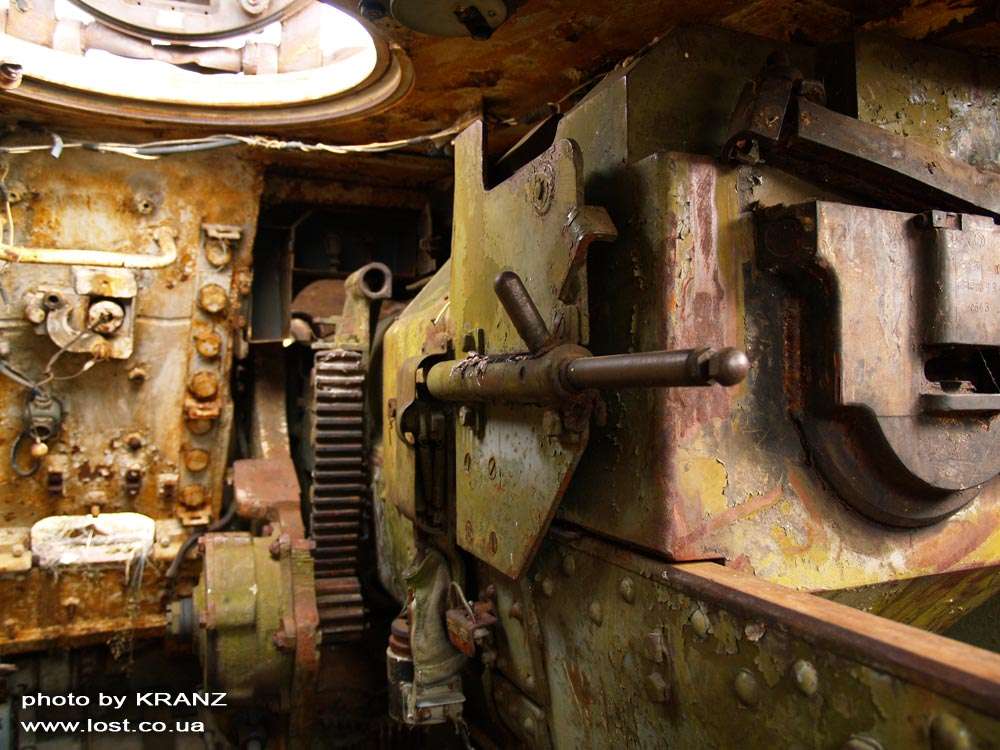 A view from inside number 100. The 152 mm ML-20S gun breech is on the right side of the image. Image courtesy of Yevgen KRANZ Goncharenko, and lplaces.com.
A view from inside number 100. The 152 mm ML-20S gun breech is on the right side of the image. Image courtesy of Yevgen KRANZ Goncharenko, and lplaces.com.
After their role as the most lethal bulldozers in history came to an end, the ISU-152s were simply parked up and left, like so many other vehicles used in the clean up.
Their very existence was not known to the West for decades, but more recently they have become one of the many points of interest for visitors in the Exclusion Zone.
Where are they Today?
The locations of the ISU-152s have been known until recently. Number 129 was located in Prypiat, but was reportedly moved in the past to an unknown fate.
Number 130 was situated among other scrap vehicles from the clean up in the Exclusion Zone, and likely remains in the same place today.
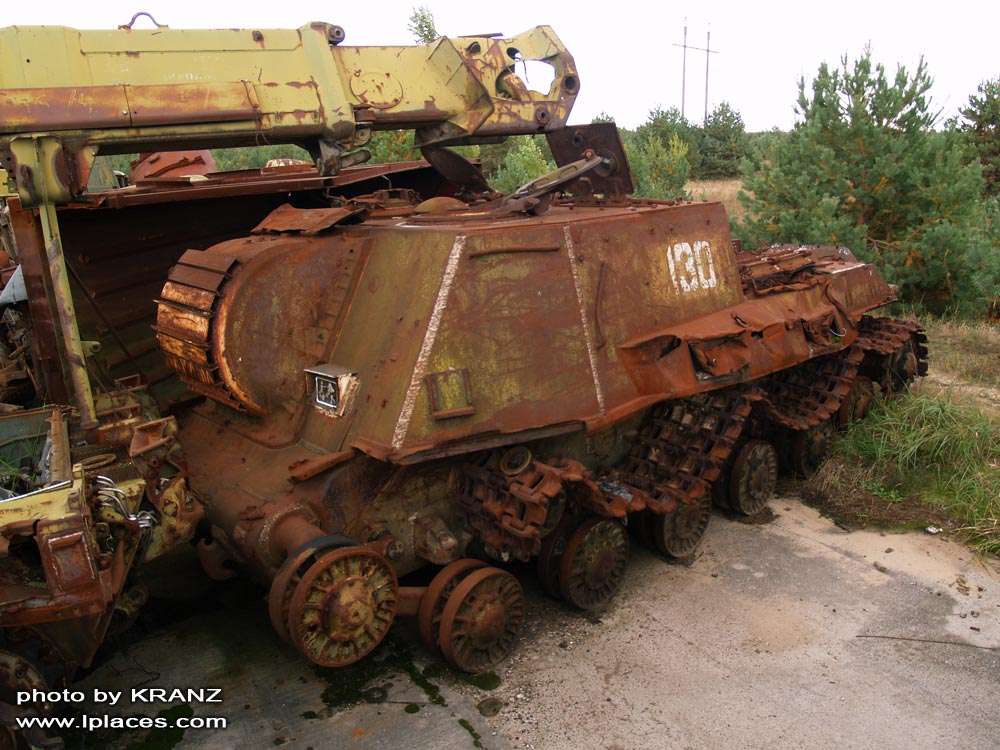 ISU-152 number 130. The gun was removed, and the opening was covered with lead. Image courtesy of Yevgen KRANZ Goncharenko, and lplaces.com.
ISU-152 number 130. The gun was removed, and the opening was covered with lead. Image courtesy of Yevgen KRANZ Goncharenko, and lplaces.com.
The most famous one, number 100, has sat just outside Prypiat for years, not far from the powerplant. There are plans to relocate it to a museum exhibition in Prypiat in the future.
However, things may have changed since the Russian invasion of Ukraine in February 2022.
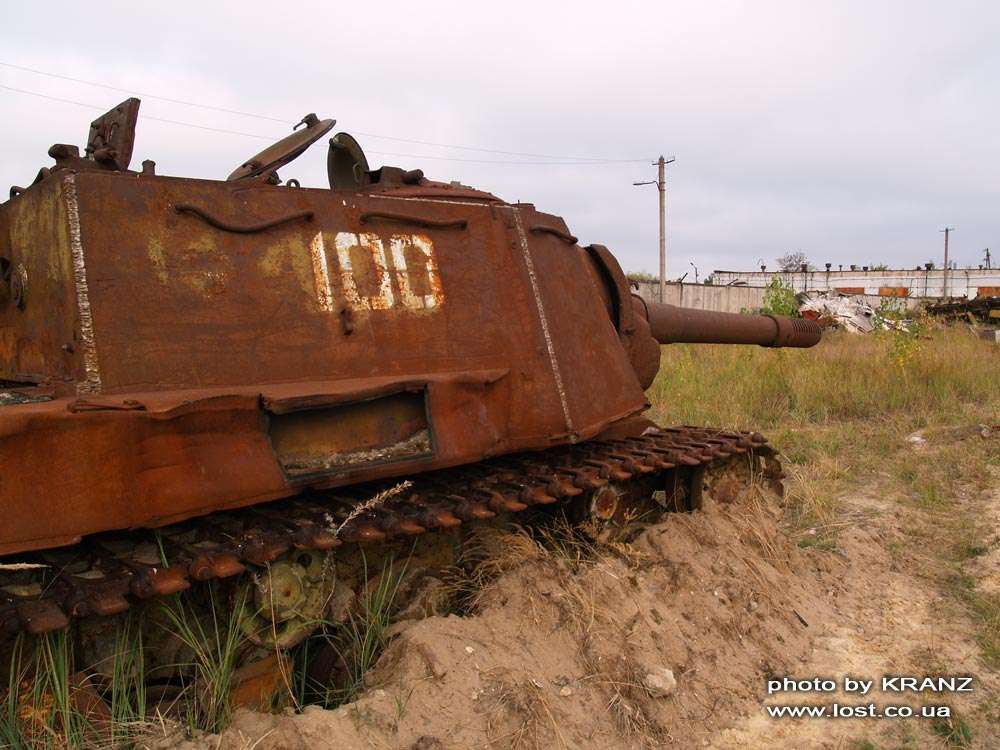 ISU-152 bort number 100, in its last known location. Image courtesy of Yevgen KRANZ Goncharenko, and lplaces.com.
ISU-152 bort number 100, in its last known location. Image courtesy of Yevgen KRANZ Goncharenko, and lplaces.com.
According to a source who knows the area well, the ISU-152 was in its place during a visit just days before the invasion, but there are fears that it may have been moved or tampered with by Russia military forces when they were in that area.
We are currently unable to confirm the whereabouts of the ISU-152, but when we can we will update this article.
Conclusion
The Chernobyl disaster had huge costs for the Soviet Union in personnel, money, equipment and international reputation. To this day in the exclusion zone, there are areas full of various rotary wing aircraft, motor vehicles of all types, and several ISU-152s, all totally abandoned and quietly rusting away.
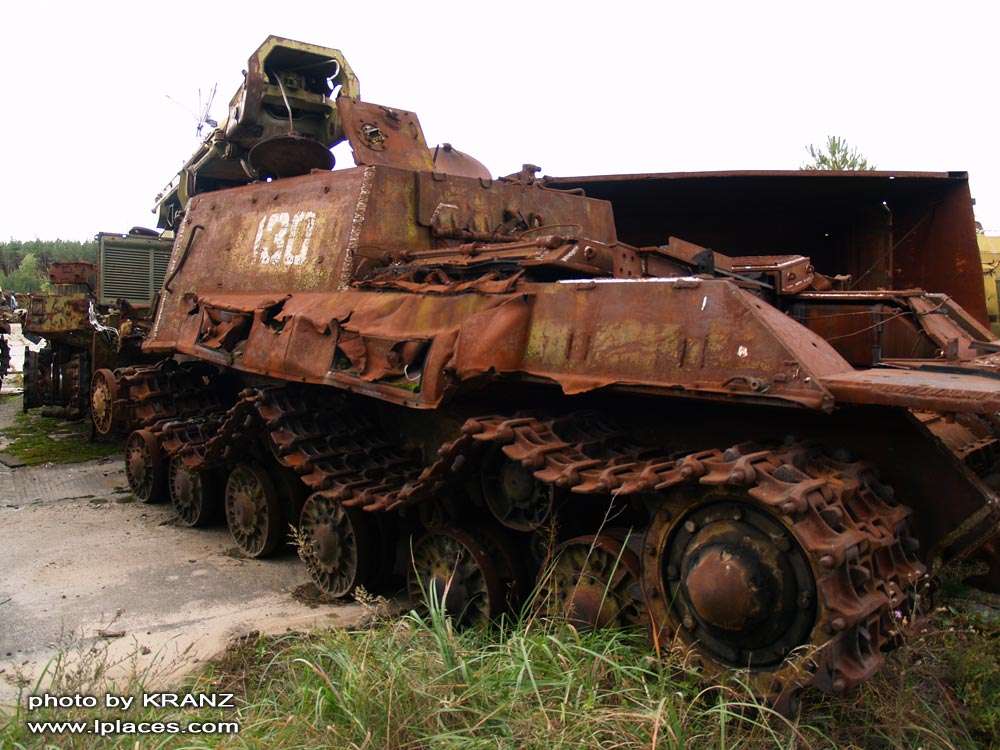 Vehicle number 130. We are unable to verify its exact location (2022). Image courtesy of Yevgen KRANZ Goncharenko, and lplaces.com.
Vehicle number 130. We are unable to verify its exact location (2022). Image courtesy of Yevgen KRANZ Goncharenko, and lplaces.com.
All were so heavily contaminated by their employment in the clean-up that they were unable to be returned into service, as no amount of decontamination could make these aircraft, vehicles and AFVs like the ISU-152 safe for normal use again.
Today, they rest as monuments to the folly of slipshod safety procedures in nuclear power generation, and as a warning to future generations.
News
The Hanging Temple: China’s 1,500-Year-Old Cliffside Marvel of Faith and Engineering
The Hanging Temple: China’s 1,500-Year-Old Cliffside Marvel of Faith and Engineering Perched precariously on the cliffs of Mount Heng in Shanxi Province, China, the Hanging Temple, also known as Xuankong Temple, Hengshan Hanging Temple, or Hanging Monastery, is an architectural…
The Willendorf Venus: A 30,000-Year-Old Masterpiece Reveals Astonishing Secrets
The Willendorf Venus: A 30,000-Year-Old Masterpiece Reveals Astonishing Secrets The “Willendorf Venus” stands as one of the most revered archaeological treasures from the Upper Paleolithic era. Discovered in 1908 by scientist Johann Veran near Willendorf, Austria, this small yet profound…
Unveiling the Maya: Hallucinogens and Rituals Beneath the Yucatán Ball Courts
Unveiling the Maya: Hallucinogens and Rituals Beneath the Yucatán Ball Courts New archaeological research has uncovered intriguing insights into the ritual practices of the ancient Maya civilization. The focus of this study is a ceremonial offering found beneath the sediment…
Uncovering the Oldest Agricultural Machine: The Threshing Sledge’s Neolithic Origins
Uncovering the Oldest Agricultural Machine: The Threshing Sledge’s Neolithic Origins The history of agricultural innovation is a fascinating journey that spans thousands of years, and one of the earliest known agricultural machines is the threshing sledge. Recently, a groundbreaking study…
Nara’s Ancient Sword: A 1,600-Year-Old Protector Against Evil Spirits
Nara’s Ancient Sword: A 1,600-Year-Old Protector Against Evil Spirits In a remarkable discovery that has captured the attention of archaeologists and historians alike, a 7.5-foot-long iron sword was unearthed from a 1,600-year-old burial mound in Nara, Japan. This oversized weapon,…
The Inflatable Plane, Dropped Behind the Lines for Downed Pilots
Experimental The Inflatable Plane, Dropped Behind the Lines for Downed Pilots The Inflatoplane from Goodyear was an unconventional aircraft developed by the Goodyear Aircraft Company, a branch of the renowned Goodyear Tire and Rubber Company, also famed for the Goodyear…
End of content
No more pages to load











